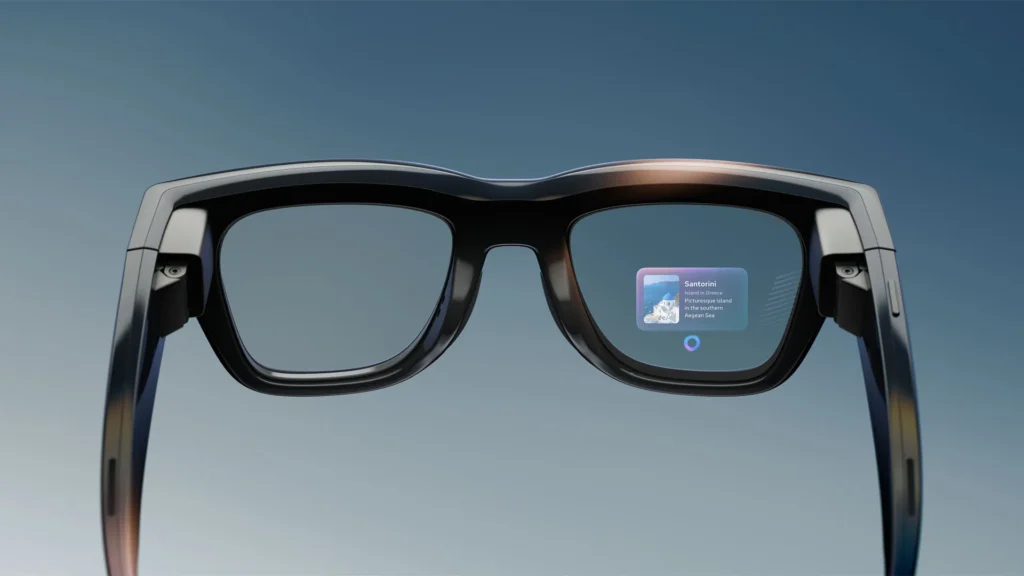Introduction – What Are “Meta Glasses”?
Meta (formerly Facebook) has expanded into wearable tech with its line of smart glasses / AI glasses under brands such as Ray-Ban and Oakley. In 2025, Meta introduced a new generation of models including Ray-Ban Display, Ray-Ban Meta Gen 2, and Oakley Meta Vanguard. These glasses combine camera/video capture, display, AI assistants, gesture controls, and connectivity features.

Key Models & Features (2025 Lineup)
| Model | Highlight Features | Display & Camera | Battery / Use Case | Price / Release |
|---|---|---|---|---|
| Ray-Ban Display | First Meta model with built-in AR display, gestures via Neural Band wristband; live subtitles, messaging, navigation, Meta AI responses. Reuters+4Road to VR+4Tom’s Guide+4 | 12MP camera, display internal on right lens; 600×600px, ~20° field of view; uses Qualcomm Snapdragon AR1 Gen1. Road to VR+2Tom’s Guide+2 | Mixed use: ~6 hours, with collapsible charging-case adding ~24 more / total ~30 hours. Comes with Neural Band. Tom’s Guide+1 | USD $799; available starting September 30, 2025 in US; expansion to Canada, UK, France, Italy early 2026. Facebook+1 |
| Ray-Ban Meta (Gen 2) | Upgraded features: better battery, improved video capture (3K), refined Meta AI functionality. Facebook+2Android Central+2 | ~12MP camera, ultrawide lens, open-ear speakers, etc. Android Central+2Moor Insights & Strategy+2 | Up to ~8 hours typical use; with charging case for extra battery life. The Indian Express+1 | Price lower than Display model (varies by region) — target mass consumer segment. Android Central+1 |
| Oakley Meta Vanguard | Sports / fitness oriented: rugged design, wide-angle lens, optimized for outdoors & movement; integration with fitness platforms (Garmin, Strava). TechCrunch+1 | 12MP camera, ~122° wide-angle view, video capture up to 3K. Durable lens, wind-noise microphones. TechCrunch | Battery ~9 hours; charging case adds extra hours. IP67 dust/water resistance. Fast charging to 50% in some minutes. TechCrunch | Priced around USD $499; release starting October 21, 2025, in USA & Canada — global rollout follows. TechCrunch+1 |
What’s New in 2025 Compared to Earlier Meta Glasses
- First built-in display in lens (Ray-Ban Display), shifting from “camera + audio” models to more visual feedback. Road to VR+1
- Gesture control via wristband (Neural Band) enabling hands-free interaction. Road to VR+1
- Brighter displays (up to several thousand nits) for visibility in daylight. Road to VR+1
- Enhanced battery life, especially in “Gen 2” and sport models. Facebook+1
- Better audio & microphone systems, wind-noise optimization for outdoor use. TechCrunch+2Road to VR+2

Use Cases – Who Are Meta Glasses For?
- Everyday Users: Messaging, live captioning / translation, notifications, hands-free video & photo capture.
- Outdoor / Fitness Enthusiasts: Oakley Meta Vanguard tailored for athletes, resilient design, integration with fitness apps.
- Tech & Early Adopters: AR display features (Ray-Ban Display), experimentation with AI assistants and ambient computing.
- Professionals & On-the-Go Creators: Content capture, livestreaming, documenting events, using Meta AI to assist in productivity.
Pricing, Availability & Global Release
- Ray-Ban Display: USD $799; US release Sept 30, 2025. Expanding to Canada, UK, France, Italy in early 2026. Facebook+2Road to VR+2
- Oakley Meta Vanguard: USD $499; from October 21, 2025, in the US & Canada initially, then more countries. TechCrunch
- Gen 2 Ray-Ban: price around USD $379 in many markets; varies; available in more countries. Facebook+1
Technical & Performance Summary
- Display Resolutions: ~600×600 px, ~20° Field of View. Road to VR+1
- Camera: 12 MP, wide or ultrawide lens, video up to 3K or high-fps 1080p depending on model. TechCrunch+1
- Audio: Open-ear speakers, multiple microphones (5 mic arrays in many models), voice control, gesture / wristband controls. Road to VR+1
- Durability: Some IP ratings (IP67 / water & dust resistance) especially in sport models. Glasses + charging case for expanded battery. TechCrunch

Privacy, Ethical & User Considerations
- Recording and display features raise concerns about privacy (coding for LED indicators, awareness when recording).
- Battery drain under mixed vs display-heavy use.
- Cost: higher end models are expensive; consumers must consider value per feature.
- Fashion/style trade-offs: balancing wearable design with tech weight and bulk.
Geo-Relevance & Market Differences
- United States & Canada: First market for release; strong adoption among tech early adopters.
- United Kingdom, Europe, Australia: Next wave of availability, likely by early/mid-2026 for many models.
- Asia & Emerging Markets: Later rollout; price sensitivity high, interest in display and fitness features strong.
- Local Regulations: Some places might regulate camera glasses more strictly (e.g. privacy laws in EU, UK, etc.).
Outlook & What to Watch
- How well Meta’s AI + display models perform — battery vs usability trade-off.
- Competing products from Apple, Google, Samsung, and others in the AR/AI wearable space.
- App ecosystem support: what “killer apps” emerge (navigation, translation, productivity, augmented reality overlays).
- Effectiveness of gesture controls and Neural Band reliability in daily, real-world use.
✅ Conclusion
Meta Glasses in 2025 mark a significant step forward for wearable tech. From camera-centric Ray-Ban Meta to augmented reality with Ray-Ban Display, and the athlete-focused Oakley Vanguard, Meta is pushing the boundaries of what “glasses” can do. While prices are steep, for users who value hands-free interaction, situational awareness, and smart AI features, they may provide strong value.
If you’re considering buying, think about which model fits your needs (display vs sport vs camera), battery life, price in your country, and how much you care about privacy and ecosystem support.
